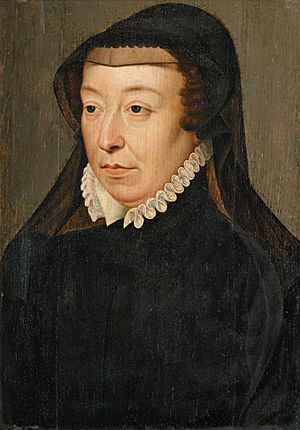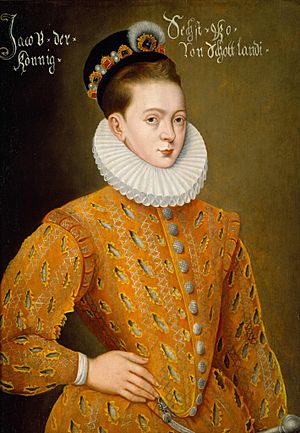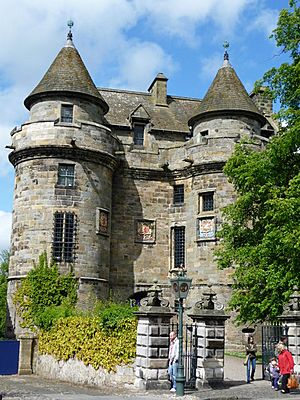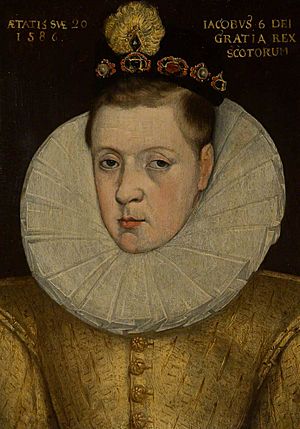Charles de Prunelé, Baron d'Esneval facts for kids
Charles de Prunelé, Baron d'Esneval (died 1624) was a French diplomat. He served as an ambassador in Scotland in 1586. His family's home, the Château d'Esneval, is located in Pavilly, Seine-Maritime, France. He is often known by his title, "D'Esneval," or sometimes "D'Aisneval" or "D'Anneval."
Contents
A Diplomat's Start: Mission to Scotland


D'Esneval became important at the French court after he married Madeleine Pinart in 1583. Madeleine was the daughter of Claude Pinart, a powerful French Secretary of State. This connection helped him get a job as a diplomat.
In 1586, D'Esneval was sent to Scotland. He was welcomed by David Beaton of Melgund, who worked for James VI, the King of Scotland. D'Esneval's wife, Madeleine, stayed in France.
Why D'Esneval Went to Scotland
Henry III of France and his mother, Catherine de' Medici, sent D'Esneval to Scotland to strengthen the old friendship between France and Scotland, known as the Auld alliance. Sending a permanent ambassador like D'Esneval showed that the French court now saw James VI as the true ruler of Scotland, not his mother, Mary, Queen of Scots, who was living in exile.
Mary, Queen of Scots, hoped D'Esneval would help her communicate with her son, James VI. She also wanted him to support the Auld Alliance. She asked D'Esneval to send her updates on James's health and what was happening in Scotland. However, she thought D'Esneval was young and didn't know much about Scottish affairs. She trusted his companion, Monsieur de Courcelles, more. Courcelles was an experienced secretary who had worked for the French ambassador in London.
D'Esneval's Arrival and First Impressions
D'Esneval arrived in Leith, Scotland, on January 13. He was only 24 years old at the time. The Master of Gray wrote to Francis Walsingham, an English spy chief, saying D'Esneval was "very young." He also noted that Courcelles was D'Esneval's main advisor.
The English were watching D'Esneval closely. William Cecil, a top English official, described D'Esneval as "a man of great living but of little understanding." He worried that Courcelles, who was very loyal to Mary, Queen of Scots, would cause trouble.
D'Esneval met with King James VI in February. When the English diplomat Thomas Randolph arrived in Edinburgh, James VI told him that D'Esneval was younger than him and had no experience in Scotland. Randolph reminded the king that the ambassador's goals were what mattered most.
Efforts Against the English Treaty
D'Esneval and Courcelles tried to stop Scotland from signing a treaty with England, known as the Treaty of Berwick (1586). They wanted Scotland to remain allied with France. However, their efforts failed. This was partly because their Scottish ally, James Stewart, Earl of Arran, was sent away from court. Also, England offered James VI money, which was very appealing.
D'Esneval also spoke to James VI about French concerns. He argued that Scottish soldiers should not be hired to fight for the Protestant King of Navarre in France. Some of D'Esneval's letters were secretly read by the English, who used them to understand French plans.
Portraits and Royal Diplomacy

King James VI spent the summer of 1586 at Falkland Palace. D'Esneval stayed with him there. While at Falkland, D'Esneval brought up a special request from Mary, Queen of Scots. She wanted a life-size portrait of her son, James VI. She had written to D'Esneval asking him to get a picture "taken from his own person."
James VI was happy that his mother cared about him. He suggested that a copy of a recent portrait could be made by a painter. He said this painter was the only good one in Edinburgh and was very busy.
Marriage Plans and Secret Messages
Catherine de' Medici was very keen to know about James VI's marriage plans. She wanted to know if he would marry her daughter, Catherine of Bourbon, or a Danish princess. D'Esneval wrote to her, explaining that James had sent his representatives to England to discuss the treaty. He also mentioned the painter and the portraits. James planned to send the first version of his portrait to Denmark.
Meanwhile, in France, an English spy tried to listen in on Secretary Pinart (D'Esneval's father-in-law) discussing D'Esneval's letters with Catherine de' Medici. This shows how important D'Esneval's reports were.
In July, James VI sent Peter Young and Colonel William Stewart to Denmark to talk about his possible marriage. Courcelles noted their return and understood that their mission also involved discussions about Orkney and one of the Danish king's daughters.
A portrait of a young James VI, believed to be by Adrian Vanson, was bought for Edinburgh Castle in 1996. This might be the picture that was sent to Denmark. Another version of James's portrait from 1586 is displayed at Falkland Palace.
When D'Esneval left Scotland, he wrote to Courcelles from Berwick-upon-Tweed. He asked Courcelles to talk to the painter about a "landscape" (perhaps meaning the king's portrait or another artwork) to agree on a price and pay him.
Even though other diplomats tried to arrange a marriage between James VI and Catherine of Bourbon, James eventually married Anne of Denmark in 1589. Denmark was seen as a neutral country in the religious conflicts happening in Europe at the time.
The Babington Plot and D'Esneval's Report
D'Esneval left Scotland in August 1586. Soon after he returned to London, news broke about the arrest of Anthony Babington. D'Esneval and the French ambassador in London, Châteauneuf, both described how people celebrated with bonfires and church bells ringing. They met with Elizabeth I at Windsor Castle. After five days in London, D'Esneval went to Rye to catch a boat back to France. He needed to tell Henry III all the details.
D'Esneval wrote a report for Henry III about the discovery of the Babington Plot. This plot involved a plan to remove Elizabeth I from power and put Mary, Queen of Scots, on the English throne. D'Esneval reported that some of the people working for him and Châteauneuf were arrested during the search for Babington in London.
He heard that Babington was found hiding in a wood (he was caught near Harrow on August 14). He also reported that Bess Pierrepont was taken to the Tower of London, Mary, Queen of Scots, was moved to Tixall, and her secretaries were arrested. There was even talk that the prisoner in the Tower might be Mary herself.
D'Esneval sent similar news to Courcelles, who had stayed in Scotland. Queen Elizabeth was angry that Courcelles remained at the Scottish court. At first, D'Esneval thought the Babington affair was just a small matter, "the special affection which some young gentlemen students had to the religion rather than an enterprise against the state."
On November 2, 1586, Henry III wrote to James VI about the "ill news of his mother" that he had received from D'Esneval. Henry III hoped that James VI would do everything he could to ensure his mother's safety when talking with Queen Elizabeth. Courcelles remained in Scotland as the French diplomat.
|


